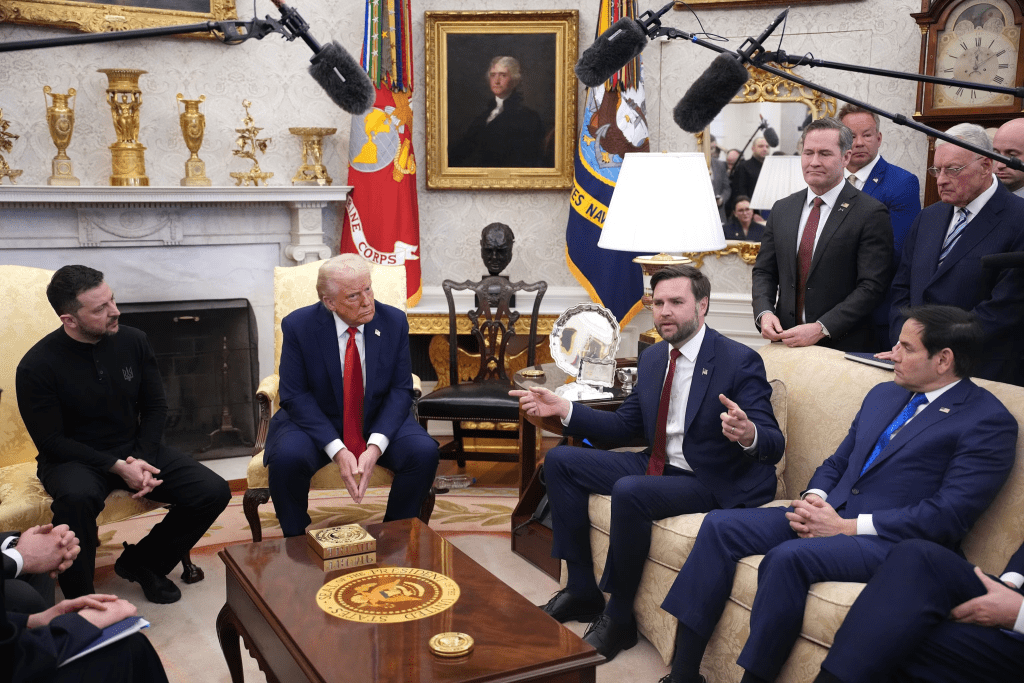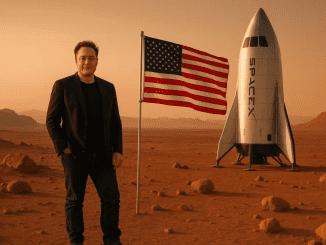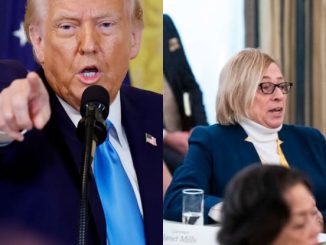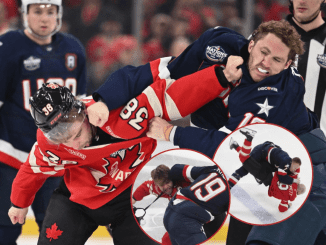Unprecedented Clash in the Oval Office: Trump and Zelenskyy Engage in Heated Exchange Over Ukraine War
Washington, D.C. – In a shocking and unprecedented confrontation inside the historic Oval Office, former U.S. President Donald Trump and Ukrainian President Volodymyr Zelenskyy engaged in a fiery debate over the ongoing war in Ukraine. The high-stakes meeting, intended to cement U.S.-Ukraine relations and solidify an economic agreement, instead devolved into a tense and bitter exchange, marking one of the most dramatic diplomatic incidents in modern White House history.
The confrontation, which played out before rolling cameras, showcased deep divisions over Ukraine’s military strategy and the role of the United States in brokering peace. Trump, accompanied by Vice President JD Vance, harshly criticized Zelenskyy for his handling of the conflict, once again erroneously attributing responsibility to the Ukrainian leader rather than to Russian President Vladimir Putin, who launched a full-scale invasion of Ukraine.
A Meeting That Turned Hostile
Zelenskyy’s visit to Washington was initially focused on signing a key agreement that would grant the U.S. access to Ukraine’s valuable mineral resources—an economic move that could have strengthened bilateral ties. However, tensions boiled over when Trump and Vance accused the Ukrainian president of displaying a lack of gratitude toward U.S. efforts and aid.
The hostility reached its peak when Trump abruptly canceled the planned press conference where the agreement was supposed to be signed. Instead, he released a terse statement on social media, further escalating the diplomatic standoff.
“I have determined that President Zelenskyy is not ready for peace if America is involved, because he feels our involvement gives him a big advantage in negotiations,” Trump wrote. “I don’t want advantage, I want PEACE. He disrespected the United States of America in its cherished Oval Office. He can come back when he is ready for peace.”

Key Takeaways from the Explosive Meeting
Trump’s Ultimatum: A Deal or U.S. Withdrawal
In a stark warning, Trump signaled that U.S. involvement in the conflict could be contingent on Ukraine’s willingness to negotiate with Russia.
“You’re gambling with World War III,” Trump warned Zelenskyy as the two leaders spoke over each other in the increasingly tense meeting.
Trump then delivered what many interpreted as an ultimatum: “You’re either going to make a deal or we’re out. And if we’re out, you’ll fight it out. I don’t think it’s going to be pretty, but you’ll fight it out.”
This statement sent shockwaves through international diplomatic circles, raising concerns that Trump’s approach could leave Ukraine vulnerable and weaken Western unity against Russian aggression.
Vance Accuses Zelenskyy of Disrespect
Vice President JD Vance also took a strong stance against Zelenskyy, questioning his attitude toward the U.S. and Trump’s diplomatic efforts.
“Mr. President, with respect, I think it’s disrespectful for you to come into the Oval Office and try to litigate this in front of the American media,” Vance said pointedly. “Right now, you guys are going around enforcing conscripts to the front lines because you have manpower problems. You should be thanking the president for trying to bring an end to this conflict.”
Zelenskyy fired back, pressing Vance on whether he had ever visited Ukraine to witness the devastation firsthand.
“First of all, during the war, everybody has problems, even you. But you have a nice ocean and don’t feel it now, but you will feel it in the future,” Zelenskyy retorted, hinting at potential global consequences if Ukraine were left to stand alone against Russia.

Trump Calls Out Zelenskyy’s ‘Hatred’ Toward Putin
As the verbal sparring continued, Trump intervened again, chastising Zelenskyy for his response.
“Don’t tell us what we’re going to feel. We’re trying to solve a problem. Don’t tell us what we’re going to feel,” Trump scolded.
Earlier in the meeting, Zelenskyy had made an emotional appeal, urging Trump to take a firm stance against Putin.
“I really count on your strong position to stop Putin,” Zelenskyy said. “And you said that enough with the war. I think that’s very important to say these words to Putin at the very beginning, at the very beginning of war, because he is a killer and terrorist. But I hope that together we can stop him.”
Trump, however, has faced scrutiny for his approach to Russia, having previously referred to Zelenskyy as a “dictator” while refusing to use the same term for Putin. Instead, Trump has claimed that he trusts Putin “to keep his word” if a peace deal were reached.
Pushing back against criticism that he is siding with the Russian president, Trump insisted: “I’m not aligned with Putin. I’m not aligned with anybody. I’m aligned with the United States of America, and for the good of the world. I’m aligned with the world, and I want to get this thing over with.”
However, he appeared to imply that Zelenskyy’s personal animosity toward Putin was hindering peace negotiations. “You see the hatred he’s got for Putin? It’s very tough for me to make a deal with that kind of hate.”
The Fallout and Global Implications
The explosive confrontation between Trump and Zelenskyy signals a radical shift in U.S. foreign policy and raises urgent questions about the future of American support for Ukraine. As Trump seeks to redefine America’s role in global conflicts, his stance on Ukraine could have significant consequences for NATO allies, European security, and the broader geopolitical landscape.
With Ukraine still locked in a brutal war against Russia’s aggression, the international community is left wondering: Will U.S. support remain steadfast, or is Ukraine now at risk of losing its most powerful ally?
Conclusion
The dramatic Oval Office meeting between Trump and Zelenskyy has reshaped the narrative surrounding the Ukraine war, revealing deep tensions in diplomatic relations. As Trump continues to push for a new approach to global conflict resolution, the world watches closely to see how this evolving strategy will impact the future of Ukraine, European stability, and U.S. foreign policy at large.


